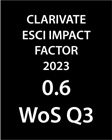Hybrid social spaces and the individualisation of religious experience in the Global North
Spatial aspects of religiosity in postmodern society
DOI:
https://doi.org/10.17649/TET.39.2.3602Keywords:
spatial turn, religiosity, religious experience, sacred and secular spaces, hybrid social spaces, individualisation, globalisation, transcendental sense makingAbstract
The study employs a spatial turn perspective to examine the evolving characteristics of religiosity in modern and postmodern societies. The analysis examines the impact of changes in social experience and action on the spatial structure, and in turn, how changes in the spatial structure over the last decade have shaped the actions and experiences of individuals, with a particular focus on the relationship to transcendence. In this way, the analysis explores the impact of the interaction of social spaces and actions on religiosity, with the aim of providing new insights into the interpretation of religious phenomena through a novel approach in the study of religion.
The paper initially addresses the shift in perspective brought by the spatial turn, emphasising the potential of spatial analysis for social scientific analysis. It then traces the changes in the spatial structure of society, which result in a dissolution of the sharply segregated spatial structure of modern society and a more fluid structure of spaces in postmodern society. Conversely, the study also interprets the transformations in the hierarchy of society, which permit a greater scope for interpretations of reality that are not directed from above or, when appropriate, more individualised. The principal narrative of the analysis is an examination of the impact of this series of changes on religiosity and religious experience. In this way, the paper examines the impact of individualisation, hybridisation and globalisation on contemporary religiosity in Western civilisation, offering a detailed analysis of the ways in which these transformations are shaping religious practices and beliefs.
The paper argues that these spatial structural changes are reinforcing the growth of more individualised forms of religiosity, which are often divorced from traditional, institutionalised forms of religious practice. Conversely, it allows for the emergence of subject-organised 'patchwork religiosity', which inevitably gives rise to a new type of religious syncretism. In a novel way, the reflection provides an analysis of the spatial aspects of this transformation. In capturing these features, the paper posits that the transformation of the social spatial structure and individual agency has given new content to religious experience. Furthermore, the religiosity of postmodern society differs from that of the modern era not only in its content but also in its social role. The strengthening of secular identities in the modern era undermined the previously existing integrative function of religion, thereby creating space for non-religious forms of integration to emerge and gain prominence in this context.
The study also shows the process of how, in postmodern society, religiousness, which is now also present in public space, becomes a factor - albeit of diminished importance - in the integration of society. On the other hand, the analysis illustrates how religion can become a point of identification in the new type of spatial structure of society by emphasising difference. It interprets all these changes in terms of the modifications of the spatial structure of society, showing how spatial relations play an important role in the emergence of new forms of religiosity.
Downloads
Published
How to Cite
Issue
Section
License
Copyright (c) 2025 Bognár Bulcsu

This work is licensed under a Creative Commons Attribution 4.0 International License.
Authors wishing to publish in the journal accept the terms and conditions detailed in the LICENSING TERMS.






